
Trogen is a municipality in the canton of Appenzell Ausserrhoden in Switzerland. The town is the seat of the canton's judicial authorities.
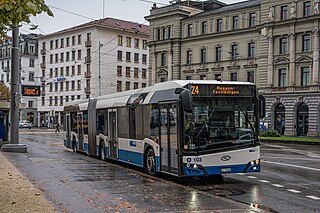
Verkehrsbetriebe Luzern (VBL) is the main provider of public transport in the Swiss city of Lucerne. It operates some 92 buses and 74 trolleybuses on 25 daytime routes, as well as 5 overnight services and one funicular service.
Carrosserie HESS AG is a bus, trolleybus and commercial vehicle manufacturer based in Bellach, Switzerland. Their products can be found operating in several countries, including the United States and Canada.

A bi-articulated bus or double-articulated bus and sometimes train-bus, tram-bus, trackless tram or double bendy bus is a type of high-capacity articulated bus with an extra axle and a second articulation joint, as well as extended length. Bi-articulated buses tend to be employed in high-frequency core routes or bus rapid transit schemes rather than in conventional bus routes.
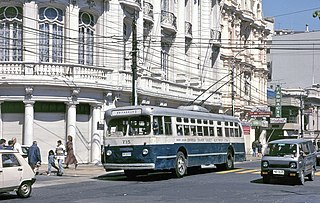
Trolleybuses in Valparaíso, Chile, have provided a portion of the public transit service since 1952. The trolleybus system is the second-oldest in South America. The originally state-owned system has been privately owned since 1982, and since 1994 it has been Chile's only operational trolleybus system. Almost half of its vehicles were built in 1946–52 by the Pullman-Standard Company, and they are the oldest trolleybuses in regular service anywhere in the world. Those vehicles were collectively declared a national monument by the Chilean government in 2003. They helped the city gain its designation by UNESCO as a World Heritage Site, and have been called "a heritage sight in their own right" by at least one travel writer.
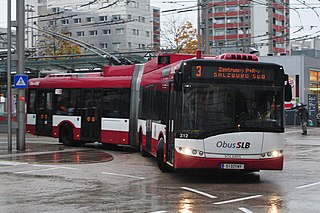
The Salzburg trolleybus system forms part of the public transport network serving Salzburg, capital of the federal state of Salzburg in Austria. Opened on 1 October 1940, it replaced the Salzburg tramway network.

The Lausanne trolleybus system forms part of the public transport network of Lausanne, in the canton of Vaud, Switzerland. The system has been in operation since 1932 and is the third-oldest surviving trolleybus system in the world, after those of Shanghai and Philadelphia.

The Fribourg trolleybus system forms part of the public transport network in Fribourg, capital of the canton of Fribourg, Switzerland. The system also serves the neighbouring municipalities of Villars-sur-Glâne and Givisiez, using one line in each case.

The La Chaux-de-Fonds trolleybus system forms part of the public transport network in La Chaux-de-Fonds, in the canton of Neuchâtel, Switzerland.

The Geneva trolleybus system forms part of the public transport network in Geneva, Switzerland. It is the second largest trolleybus system in Switzerland, after the Lausanne system.

The Neuchâtel trolleybus system is part of the public transport network in Neuchâtel, Switzerland. Opened in 1940, it gradually replaced the urban lines of the Neuchâtel tramway network.

The Neuchâtel tramway is a tramway forming part of the public transport system in Neuchâtel, a city in Switzerland.

The Lucerne trolleybus system forms part of the public transport network of Lucerne, which is the capital city of the canton of Lucerne, Switzerland. Opened in 1941, the system had replaced the Lucerne tramway network by 1961.
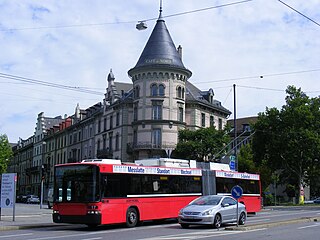
The Bern trolleybus system is part of the public transport network of Bern, the capital city of Switzerland. Opened in 1940, it combines with the Bern S-Bahn, the Bern tramway network and Bern's urban motorbus network to form an integrated all-four style scheme.
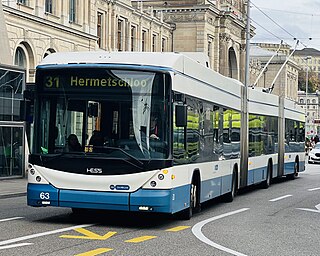
The Zurich trolleybus system is part of the public transport network of Zurich, Switzerland. Opened in 1939, it combines the Zurich S-Bahn, the Zurich tramway network and Zurich's urban motorbus network to form an integrated all-four style scheme.

The Montreux/Vevey trolleybus system, also known as the Vevey–Villeneuve trolleybus line, forms part of the public transport network in Montreux and Vevey, in the canton of Vaud, Switzerland. It comprises a single 12.75 km (7.92 mi) long trolleybus route along the length of the Riviera vaudoise on the north shore of Lake Geneva.

The Schaffhausen trolleybus system is part of the public transport network of Schaffhausen, capital city of the canton of Schaffhausen, Switzerland, and the adjacent town of Neuhausen am Rheinfall in the same canton. It is also Switzerland's youngest and smallest such system. Its route, designated as line 1, connects among others Schaffhausen railway station with the Rhine Falls.

Appenzell Railways is a Swiss railway company with headquarters in Herisau. It operates a network of railways in the cantons of Appenzell Innerrhoden, Appenzell Ausserrhoden, St. Gallen and Thurgau.

The St. Gallen–Trogen railway, or Trogenerbahn (TB), is a 9.8 kilometres (6.1 mi) long railway line in Switzerland. It links the city of St. Gallen, in the canton of St. Gallen, with Speicher and Trogen, both in the canton of Appenzell Ausserrhoden. Passenger service on the line now forms part of the St. Gallen S-Bahn, branded as the S21.

The Appenzell–St. Gallen–Trogen railway, also known as the Durchmesserlinie, is a metre gauge interurban tramway in the Swiss cantons of Appenzell Innerrhoden and Ausserrhoden and the city of St. Gallen. It is the steepest adhesion railway in Switzerland with a gradient of up to 8.0% and forms part of the network of the Appenzell Railways (AB) and the St. Gallen S-Bahn. The line's two branches were completed in sections between 1889 and 1904 by the St. Gallen-Gais-Appenzell-Altstätten Railway and the Trogen Railway. The two lines were connected by the AB with a cross-city route in 2018.























